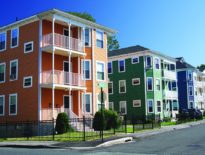John Hyde
Senior sustainability manager, Chapman Construction
Age: 46
Industry experience: 22 years
Newton-based Chapman Construction is leading by example in setting a goal of shrinking its own carbon footprint, while it continues to work with clients on their own sustainability projects. John Hyde recently was promoted to senior sustainability manager, where he will oversee the company’s internal transition away from fossil fuels. Chapman Construction plans to install electric heating and cooling systems and a solar array at its 18,000-square-foot headquarters, complementing its existing fleet of electric vehicles. Since joining Chapman Construction in 2011, Hyde has overseen net-zero projects for clients Southeast Land Trust and Mass Audubon, and is currently overseeing the company’s first Passive House project, Element Care’s PACE (Program of All-Inclusive Care for the Elderly) Center in Boston’s Brighton neighborhood.
Q: What are the upfront costs and anticipated operational savings from Chapman Construction’s carbon neutrality initiative?
A: We’ve always done sustainability work, but as LEED projects have tapered off over the past 10 years or so we’ve been looking to take it to the next level. Around January, we started to kick around the idea of going carbon neutral. We believe in this stuff and we want to lead by example, and decided to go carbon-neutral by 2030. For us, the biggest capital expenses are going to be related to HVAC and solar. We have gas-fired rooftop units whose life expectancy is around 15 years, and most of them are beyond their useful life. It’s a good time to make a switch to heat pumps. We’ve got an open concept office, so we’ll be able to easily access and reuse a lot of our existing ductwork. And we need to rework our exhaust system for the energy recovery ventilators, and to bring some fresh air into the building. The other big component is solar in the parking lot and the rooftop. We’ll be able to generate all the electricity on-site and avoid buying the offsets. We have an array now that does about 80 percent of our electricity use, so we’re going to have to more than double that to pick up the additional loads from the heat pumps and the electric vehicles. Our next steps are air resealing to reduce our heating and cooling loads, so we’ll do some building diagnostics to find leaks and seal those up. We’ve done some preliminary tests and the building is fortunately pretty tight now. Once this is up and running, we’re going to have no operational [energy] expenses at all and potentially make some additional revenues with the addition of solar.
Q: What new energy sustainability regulations are prompting the most discussions with clients currently?
A: BERDO 2.0 [Building Emissions Reduction and Disclosure Ordinance] only applies to Boston right now, but a lot of owners anticipate it’s going to potentially be applied across the state. They’re looking at that pretty seriously. It sets emission targets for new and existing buildings over 20,000 square feet, and that’s really raised the awareness of building owners about carbon emissions. So, we are seeing a lot of activity. It affects new buildings, and people are quickly making the switch to electric equipment so they don’t have to pull it out in five years and replace the gas-fired equipment. Another program which has been going on for a few years is Mass Save, funded by the energy service providers, and they’ve done a terrific job of incentivization to build multifamily projects to Passive House standards. You’ve got a huge stock of affordable housing projects coming online across the state. Now it’s moving beyond multifamily, with the biggest Passive House office building in the world [Winthrop Center] being built in Boston.
Q: How is the decarbonization push affecting decisions on building acquisitions?
A: With all of the focus on carbon reduction, people are going to look at a building and realize the value of the building is going down if it has fossil fuel equipment, because they are going to have to replace all the equipment. That affects decisions on buying and selling buildings. We have a lot of discussions about net-zero. We’ve been getting calls from people for deep energy retrofits. Those are challenging, depending upon the extent of the work, and whether the building is occupied or not. It seems like they are the next piece of the carbon puzzle. Clients are starting to talk more about embodied carbon, and we are starting to see more activity on that front. The embodied carbon is realized when the building is built, and stays for a long time. We can compare the different types of materials like steel, concrete, wood and insulation, compare the embodied carbon and make recommendations to the design team and owner. That’s the next frontier.
Q: How much growth are you seeing in the use of cross-laminated timber as a building material in Massachusetts?
A: CLT is a great product and we’ve seen an uptick in Massachusetts. It’s being marketed heavily and [nonprofit industry organization] WoodWorks gives you free design support for engineers. But generally, it’s coming from Europe or Canada, and there’s a six-month lead time. So, if it’s not a large amount of CLT, the shipping costs can end up being pretty expensive. But it’s definitely gaining popularity in the industry. The embodied carbon is much less than steel or concrete. And we have to be careful about harvesting CLT and it being sourced from responsibly managed forests. Otherwise, there’re potential negative impacts. But they go up quicker, they require less labor and there’s less waste.
Q: How will the Inflation Reduction Act affect the green building industry?
A: In general, it’s a huge win. It includes tax credits and incentives for domestic production of clean energy and storage. As we transition away from fossil fields and toward electricity, the electric grid is basically going to double in the next 30 years. Our renewable energy production will have to triple to support it. It’s great to incentivize greening of the grid.
Q: What are Chapman Construction’s growth and hiring plans?
A: We’re at about 87 employees and we just hired three new project assistants and two project superintendents. Whether or not we have an open position advertised, we’re always looking to bring these sustainably-minded people on-board. A lot of people are drawn to us because of sustainability. I’ve been to a couple of recent career fairs, and that seems to be on peoples’ minds.
Hyde’s Five Favorite Mountain Biking Destinations
- His hometown trail network in Sherborn
- Kingdom Trails in Burge, Vermont
- NEMBA’s Vietnam Property in Milford
- Hale Reservation in Dover
- Highland Bike Park in Northfield, New Hampshire







